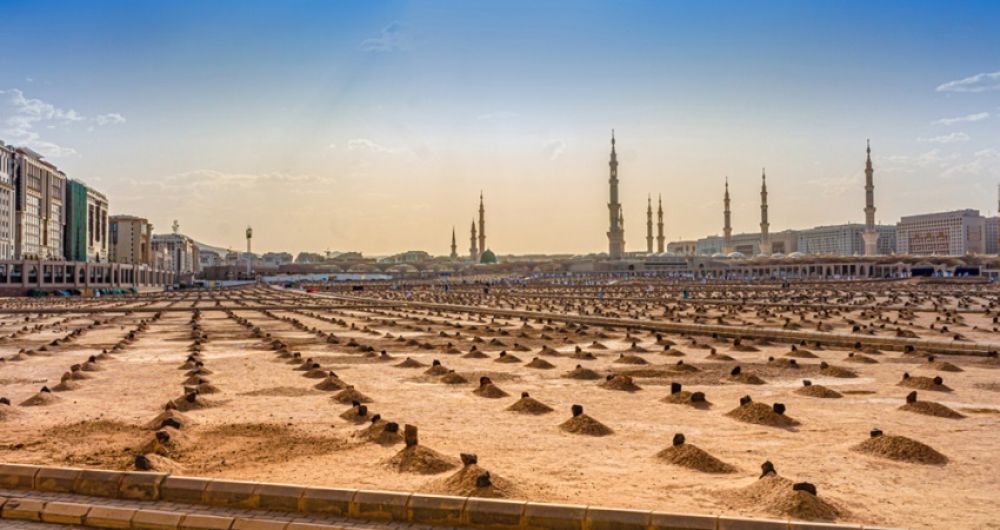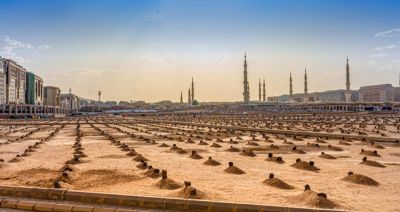

Experience the solemn atmosphere and explore the historical significance of Jannat al Baqi, the main cemetery in Medina, on a guided walking tour. Jannat al Baqi, also known as Baqi al-Gharqad, is the resting place of many of Prophet Muhammad's relatives and companions, making it a significant site for Muslims worldwide. During the tour, visitors will learn about the Islamic traditions surrounding burial and the notable individuals interred within the cemetery. The guide will recount stories and provide insights into the lives of several key figures in Islamic history, such as Uthman ibn Affan (the third caliph of Islam), Hasan ibn Ali (grandson of the Prophet), and many of the Prophet's wives and daughters. Respect for the deceased and the sacred nature of the site will be emphasized throughout the tour, which is intended to deepen one's understanding of Islamic history and culture.
This activity focuses on visiting the section of Jannat al Baqi where the family members of Prophet Muhammad are laid to rest. Visitors will have a chance to pay their respects and reflect on the familial ties of the Prophet. The tour highlights include a visit to the graves of the Prophet's daughters, such as Fatimah, and other close relatives. By participating in this experience, visitors will gain a deeper understanding of the Prophet's lineage and the significance of these individuals in the early Islamic community. The tour guide will elaborate on the role each family member played in the spread of Islam and offer visitors time for contemplation and prayer, stressing the importance of showing respect while navigating through the sacred grounds of Jannat al Baqi.
Although not inside Jannat al Baqi, this significant educational tour takes visitors to the nearby location of the Battle of Uhud, where many martyrs of this historic battle are buried. This activity can serve as an extension of one’s visit to Jannat al Baqi, as it helps to contextualize the historical narrative that encompasses the early Islamic period. The tour includes transportation to the battleground, where visitors will learn about the events that unfolded during the battle, the strategic decisions taken by both sides, and the enduring significance of the martyrs' sacrifices. Guides will recount the valor of the Prophet's uncle, Hamza ibn Abdul-Muttalib, and others who fought bravely during the conflict. The duration of the visit allows for a moment of silent tribute and includes time for reflection on the legacy of those who fell in the pursuit of their faith.
Although photography may be restricted within Jannat al Baqi itself, this activity offers participants a chance to capture the stunning Islamic architecture in the surrounding areas of the cemetery. A professional photographer will guide visitors to various vantage points where they can photograph the striking silhouettes of the minarets and domes against the skyline. This session will educate participants about the architectural elements that are synonymous with Islamic design, such as geometric patterns, arabesque motifs, and the use of calligraphy. The photographer will also provide tips on composition and lighting to help capture evocative images that reflect the spiritual and cultural essence of Medina. Note that visitors should always respect local customs and regulations regarding photography.
For Muslim visitors, the opportunity to join the evening prayer in the proximity of Jannat al Baqi is a deeply spiritual experience. This activity does not take place inside the cemetery but rather at one of the nearby mosques. Joining the local community for Maghrib or Isha prayers can be a moving and reflective moment, offering a chance to feel a connection with the faithful of the past and present. The duration of the activity is the length of the prayer itself, but visitors often spend additional time in personal supplication and contemplation. The tranquility of the evening, coupled with the historical significance of the site, creates a poignant atmosphere that enriches the spiritual journey of those who partake.
This workshop is conducted by local scholars and is aimed at providing a deeper understanding of Islamic practices and beliefs regarding death and mourning. Participants will learn about the rituals performed during and after burials in an Islamic context, the theological underpinnings of these rites, and the social and communal roles they play. The workshop will cover topics such as the preparation of the body (Ghusl and Kafan), the funeral prayer (Salat al-Janazah), and the customs surrounding visitation of the graves. By learning the significance of these practices, participants can appreciate the cultural and religious sensitivities in a Muslim-majority society. The workshop provides an in-depth look into these sacred traditions and offers an opportunity for intercultural understanding, carried out with the utmost respect for the sanctity of Jannat al Baqi and the beliefs of the Islamic faith.
Attend a lecture organized by local academic institutions or historians who specialize in the history of Islam and the Arabian Peninsula. Jannat al Baqi has been a witness to the Islamic legacy since the time of Prophet Muhammad, making it an important piece of Islamic history. Through illustrative presentations and discussions, the lecture delves into the cemetery's origin, its significance for the Muslim community, the notable individuals buried there, and its role throughout Islamic history. The lecture offers a chance to engage with scholars and gain valuable insights into the socio-religious fabric of Medieval Islamic society and how it has shaped modern Islamic thought. The event is usually held in a nearby lecture hall or educational center, respecting the quiet and respectful atmosphere of the cemetery itself.
Ziyarah, or 'visitation,' is a form of pilgrimage to holy sites and graves of important figures in Islam. A ziyarah service offers visitors a structured visitation to Jannat al Baqi that complies with Islamic etiquette and respects the sanctity of the graveyard. Visitors are often guided in groups, with a knowledgeable leader who recites appropriate prayers and supplications at each stop, providing context and biography for the individuals whose graves are being visited. The service includes teachings on the significance of remembering death in Islamic spirituality and the etiquette (adab) of visiting gravesites. This activity is often accompanied by a sense of communal solidarity and reflection, as visitors from around the world gather to remember and honor the figures who shaped early Islamic history.
In this cultural workshop, participants will have the opportunity to learn the art of Arabic calligraphy from skilled local artisans. While not directly related to the cemetery, calligraphy is an integral part of Islamic art and culture, often found on tombstones and in religious texts. The workshop takes place in a nearby cultural center or educational institute and covers various scripts, like Naskh, Diwani, or Thuluth, which are commonly used in Islamic art and architecture. Participants will practice writing with traditional tools such as bamboo qalams (pens) and ink on special paper. The workshop provides a relaxing environment to appreciate this form of artistic expression and understand its connection to Islamic history and heritage. This event offers more than just skill acquisition; it is a meditative practice that connects participants with Islamic traditions.
For a unique perspective of Jannat al Baqi, some organized tours may offer nighttime visits, providing a serene and contemplative atmosphere different from the daytime experience. The tour includes quiet reflection and prayer, giving visitors a chance to feel a powerful spiritual connection under the starlit sky of Medina. The guide will share stories and insights into the life of the Prophet Muhammad and his companions, whose final resting place is at Jannat al Baqi. Under the tranquillity of the night, participants can engage in personal reflection, connect with history, and find solace. As with all visits to Jannat al Baqi, utmost respect for the sanctity of the place is maintained throughout the tour. Visitors should verify the availability of such tours beforehand and remember that etiquette and cultural sensitivity are paramount.
